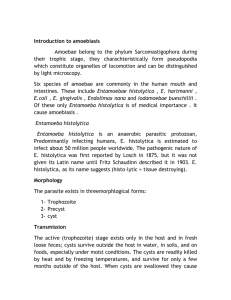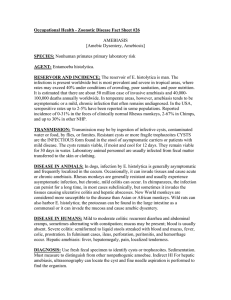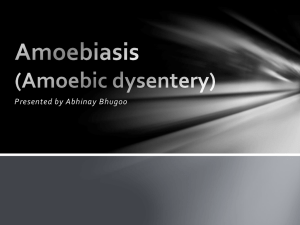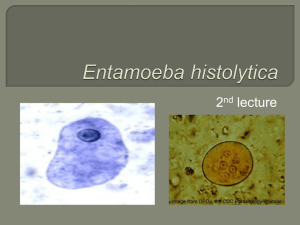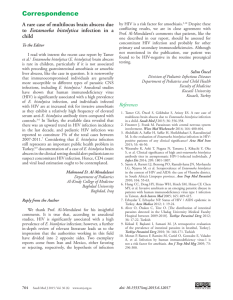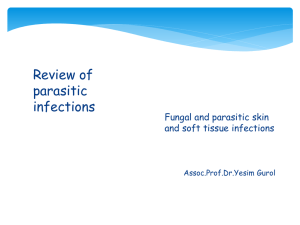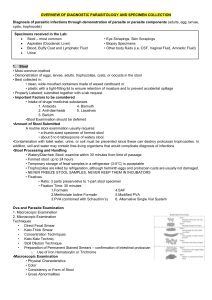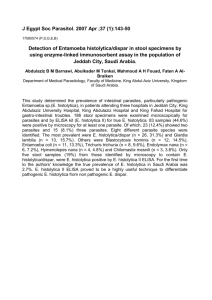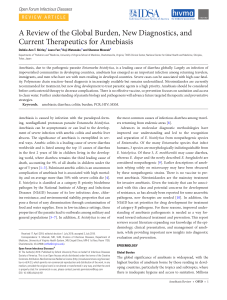JOHNS HOPKINS
advertisement
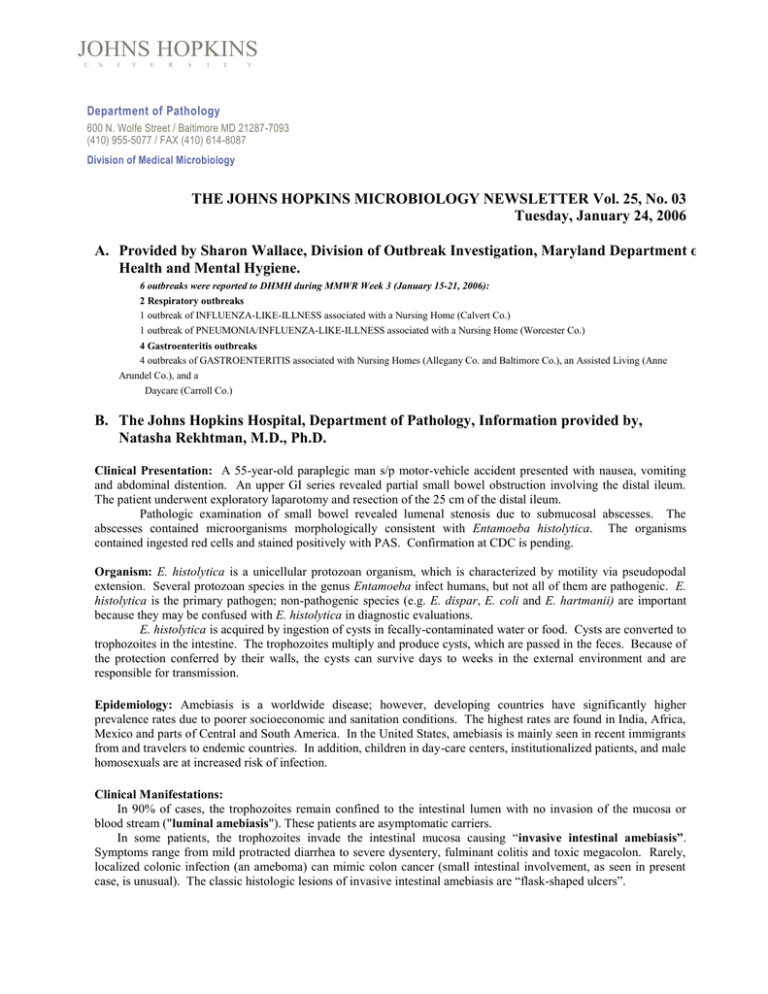
JOHNS HOPKINS U N I V E R S I T Y Department of Pathology 600 N. Wolfe Street / Baltimore MD 21287-7093 (410) 955-5077 / FAX (410) 614-8087 Division of Medical Microbiology THE JOHNS HOPKINS MICROBIOLOGY NEWSLETTER Vol. 25, No. 03 Tuesday, January 24, 2006 A. Provided by Sharon Wallace, Division of Outbreak Investigation, Maryland Department of Health and Mental Hygiene. 6 outbreaks were reported to DHMH during MMWR Week 3 (January 15-21, 2006): 2 Respiratory outbreaks 1 outbreak of INFLUENZA-LIKE-ILLNESS associated with a Nursing Home (Calvert Co.) 1 outbreak of PNEUMONIA/INFLUENZA-LIKE-ILLNESS associated with a Nursing Home (Worcester Co.) 4 Gastroenteritis outbreaks 4 outbreaks of GASTROENTERITIS associated with Nursing Homes (Allegany Co. and Baltimore Co.), an Assisted Living (Anne Arundel Co.), and a Daycare (Carroll Co.) B. The Johns Hopkins Hospital, Department of Pathology, Information provided by, Natasha Rekhtman, M.D., Ph.D. Clinical Presentation: A 55-year-old paraplegic man s/p motor-vehicle accident presented with nausea, vomiting and abdominal distention. An upper GI series revealed partial small bowel obstruction involving the distal ileum. The patient underwent exploratory laparotomy and resection of the 25 cm of the distal ileum. Pathologic examination of small bowel revealed lumenal stenosis due to submucosal abscesses. The abscesses contained microorganisms morphologically consistent with Entamoeba histolytica. The organisms contained ingested red cells and stained positively with PAS. Confirmation at CDC is pending. Organism: E. histolytica is a unicellular protozoan organism, which is characterized by motility via pseudopodal extension. Several protozoan species in the genus Entamoeba infect humans, but not all of them are pathogenic. E. histolytica is the primary pathogen; non-pathogenic species (e.g. E. dispar, E. coli and E. hartmanii) are important because they may be confused with E. histolytica in diagnostic evaluations. E. histolytica is acquired by ingestion of cysts in fecally-contaminated water or food. Cysts are converted to trophozoites in the intestine. The trophozoites multiply and produce cysts, which are passed in the feces. Because of the protection conferred by their walls, the cysts can survive days to weeks in the external environment and are responsible for transmission. Epidemiology: Amebiasis is a worldwide disease; however, developing countries have significantly higher prevalence rates due to poorer socioeconomic and sanitation conditions. The highest rates are found in India, Africa, Mexico and parts of Central and South America. In the United States, amebiasis is mainly seen in recent immigrants from and travelers to endemic countries. In addition, children in day-care centers, institutionalized patients, and male homosexuals are at increased risk of infection. Clinical Manifestations: In 90% of cases, the trophozoites remain confined to the intestinal lumen with no invasion of the mucosa or blood stream ("luminal amebiasis"). These patients are asymptomatic carriers. In some patients, the trophozoites invade the intestinal mucosa causing “invasive intestinal amebiasis”. Symptoms range from mild protracted diarrhea to severe dysentery, fulminant colitis and toxic megacolon. Rarely, localized colonic infection (an ameboma) can mimic colon cancer (small intestinal involvement, as seen in present case, is unusual). The classic histologic lesions of invasive intestinal amebiasis are “flask-shaped ulcers”. Bloodstream dissemination of E. histolytica leads to “invasive extra-intestinal amebiasis”, causing abscesses in the liver (most common), brain, spleen, and lungs. Amebic abscesses are described as having “anchovy paste”-like material. Laboratory Diagnosis: E. histolytica must be differentiated from non-pathogenic amebae, including E. coli, E. hartmanni, E. gingivalis, E. nana, and I. buetschlii. Differentiation is based on morphologic characteristics of the cysts and trophozoites. The non-pathogenic E. dispar is morphologically identical to E. histolytica; differentiation must be based on molecular or antigenic methods. Diagnostic modalities include: 1) Microscopic examination of stool, which involves saline wet mount and permanent smears stained with trichrome. E. histolytica trophozoites measure ~25um. They contain a characteristic nucleus with central karyosome and peripheral chromatin (the “ball in the socket” look). The cytoplasm contains red blood cells (this feature is relatively specific to E. histolytica). In the wet-mount, the trophozoites display unidirectional motility. Cyst forms have no more than 4 nuclei and oval-shaped chromotoid bodies. The morphologic appearance of E. histolytica compared to other amebae is shown in the diagram below. Single-sample stool microscopy misses one-half to two-thirds of infections. Therefore, at least three specimens on separate days are recommended to detect 85-95% of infections. Microscopy cannot reliably differentiate between E. histolytica and E. dispar. 2) Serology: Invasive infection with E. histolytica results in development of antibodies, while E. dispar infection (non-invasive) does not. Antibodies usually become detectable after 5-7 days following acute infection and may persist for years. Consequently, negative serology helps to exclude disease, but a positive serology is not particularly helpful since it does not distinguish between acute infection and past exposure. 3) Antigen testing: assays for detection of E. histolytica antigen (e.g. ELISA) have been recently developed for both stool and serum samples. These assays are claimed to have a greater sensitivity than stool microscopy, and some can differentiate pathogenic (E. histolytica) from non-pathogenic ameba (E. dispar) on the basis of surface lectins. Unfortunately, the preservatives in stool collection containers preclude the use of antigen detection methods, and fresh stools must be examined rapidly (<1h) before deterioration occurs. 4) PCR-based testing is recommended by CDC as the method of choice for discriminating between E. histolytica from E. dispar, but samples are also adversely affected by collection and storage in stool preservatives, and fresh samples should be prepared for analysis rapidly, before deterioration occurs. 5) Tissue diagnosis (biopsy) can be performed either to make the diagnosis of amebiasis or to exclude other causes of the patients' symptoms. This approach is not routinely recommended since mucosal amebic ulcerations increase the likelihood of perforation during the colonoscopy. Treatment: The mainstay of therapy is metronidazole. E. dispar infection does not require treatment. Asymptomatic E. histolytica infection should be treated to prevent the development of invasive disease and to circumvent transmission to others. Development of both parenteral and oral vaccines is underway. References: 1) CDC Division of Parasitic Diseases: http://www.dpd.cdc.gov. 2) Leder K and Weller PF. Intestinal amebiasis. UpToDate Jan. 2006 3) Koneman et al Color Atlas and Textbook of Diagnostic Microbiology, 6 th ed, Lippincott-Raven, 2006

